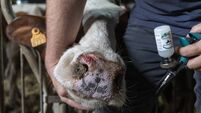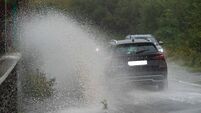Plan ahead now to get autumn calving off to a smooth start

Cows can get very aggressive around calving, so properly working equipment is essential, writes Brian Reidy.
There has been a great saying in Tipperary for many a year, about it never being a bad summer when we had the hay saved and Cork bet. Well, we haven’t had a bad summer, to be fair.
Apart from a recent moisture deficit, the farming year has been going pretty well too. The silage and hay are now safely under cover, and Liam McCarthy is back home for the winter.
Now that most of the winter feed — apart from some third cut, spring whole crop and maize silage — is behind us, we need to look at plans for the rest of the year.
Heading into the end of July, autumn calving herds are gearing up for having calves on the ground soon, in both beef and dairy herds. Both systems have different management around this time, but the principles of both are still broadly similar.
We need a healthy calf following an uneventful birth, a healthy cow that avoids metabolic issues and above all, produces the required milk post-calving, while going in calf again easily.
Most will aim to calve cows outdoors where possible, and that is ideal as long as metabolic diseases can be avoided. For many dairy herd owners, they have unfortunately learned over the years that calving them outside has resulted in problems due to cows being over-conditioned and/or consuming too much high-potassium grass.
All of this can result in milk fever and retained cleanings at a far higher than acceptable level. If this is the case on farm, then you must take control of the situation and manage intakes pre-calving.
Offering dry cows a balanced diet of minerals, fibre and an appropriate level of protein to manage condition and promote rumen bug populations pre-calving will allow the cow to hit the ground running post-calving.
If this can be done while the group remain outdoors, then great, but for many it involves simply housing cows for the last few weeks before calving to avoid unnecessary issues.
Again, at this time of year, almost all sucklers will calve while outdoors. They tend not to have as many metabolic issues as their dairy cousins, but nonetheless, they do occur, so keep an eye out that cows are not over-conditioned, are eating plenty of rougher forages and that you provide them with an appropriate source of minerals, based on what has worked well in recent years.
Also, keep a close eye on dry cows for mastitis, as there have been a lot of reported incidences in the last few weeks. There are plenty of flies about, which can be an issue.
Make sure you have everything ready indoors, just in case you need to assist with any births. Disinfect calving boxes before the season gets going. Check the water troughs in the calving boxes are working.
See the calving jack is working and the two ropes are fit for the season. Ensure your calving camera is working correctly. Make sure if you have a calving gate, it is fully functioning.
Remember cows can get very aggressive around calving, so properly working equipment is essential. Also, remember if you are in doubt about a calving, call your vet sooner rather than later.
- Brian Reidy is an independent ruminant nutritionist at Premier Farm Nutrition













